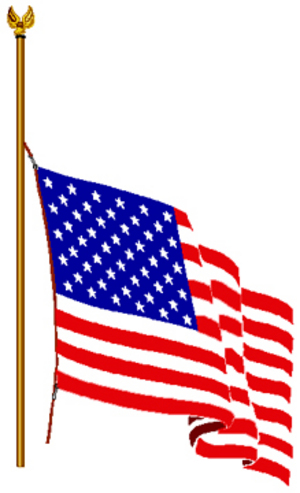Last fall, my Starter Wife, Joan, and I journeyed to Connecticut to join with friends at their granddaughter’s Bat Mitzvah. As we drove around the countryside, we noticed that the United States flag was being displayed at half-staff in front of schools, fire stations and other public buildings. We asked people in the area for whom the flag had been lowered, as we were unaware of any national figure that has died and the local papers and television did not name any famous or well-known person who had recently passed away. We were told that it was the custom in the area to fly the flag at half-staff as a gesture of respect to a local service member who had died in Iraq.
I had been unaware that the rules for flying the United States flag were not uniform across the country. The gathering of information has been illuminating.
Federal law
The United States Code, Title 4, § 7 (m) allows the President to issue an Executive Order directing the United States flag to be displayed at half-staff upon the death of present or former federal officials and on specified holidays. Since the Code also provides that the flags of the various states never be displayed higher than the federal flag, the Presidential order would apply to all states and localities. The President has the authority to order flags at half-staff upon the death or prominent world figures or, actually, whenever he (or she) feels it appropriate. In the past, proclamations have been issued calling for the half-mast display to recognize the Oklahoma City bombing, the remembrance of the 9/11 attacks, the death of Pope John Paul II, the Space Shuttle Columbia disaster in 2003, the victims of Hurricane Katrina, the Indian Ocean earthquake and tsunami, the deaths of Coretta Scott King and Rosa Parks, and the Virginia Tech massacre.
It is self-evident that the President would not issue such a proclamation to protest administration policy; other lesser jurisdictions have no such hesitation!
State and local customs and laws
The federal statute authorizes the Governor of each state to direct the United States flag to be displayed at half-staff, “in the event of the death of a present or former official of the government of any State, territory, or possession of the United State. ..”
That sounds all-inclusive, but does not explain the half-staff flags in Connecticut. In that state, the state and some municipalities have directed the flag to be lowered to recognize the death of a local serviceperson. Moreover, various states, and some municipalities, have used the flag to demonstrate a political agenda or position.
New York, for example, tries to have it both ways; a state statute provides that flags may be flown at half-staff during special periods of mourning designated by the President of the United States or the Governor of New York, and to commemorate the death of a personage of national or State standing or of a local serviceman, official or public servant. New York takes the position that every serviceman or woman is, de facto, a public official of the state. As we learned from our trip to Connecticut, the Governor of that state and some localities commonly issue proclamations upon the death of a service member.
At least it is clear that, by law, the American flag and that of the respective states may be flown at half staff upon the order of the President or Governor, based on limited and very specific criteria. As a matter of practice, lesser officials have taken similar action. There are instances where the Mayor of a city has made a similar “statement”. In 1970, for example, John Lindsey, then mayor of New York City, directed that flags in the city be lowered as a protest and in memory of students killed at Kent State University by members of the Ohio National Guard. In at least one reported case, a pizza shop owner in a suburb of Albany, New York, lowered his personal American flag to protest the war in Iraq, notwithstanding this might well be illegal under the Flag Code. This act prompted the City Manager of Long Beach, a community on New York’s Long Island, to make a similar declaration.
Last month, in the city of Gretna, Nebraska, residents didn’t wait for any official proclamations to start lowering flags in honor of Army Cpl. Matthew Alexander. When a Nebraska soldier is killed in combat Gov. Dave Heineman lets officials in the soldier’s hometown decide whether to lower flags to half-staff.
According to the Omaha World Herald, many citizens and business owners moved their flags to half-staff as soon as word came that Alexander had been killed in Iraq on May 6. Gretna Mayor Tim Gilligan ordered the lowering of flags flying over city offices. Gretna is a tight-knit community, Gilligan said, and many people felt that lowering their flags was one way to support Alexander and his family.
Not everyone agrees, however, about when flags should be lowered in mourning. Some say lowering the flag too often is serving as a subtle anti-war gesture, cheapens the tribute and may run counter to federal guidelines. Others say such tributes are appropriate and that fallen soldiers are at least as deserving as politicians. Since the start of the Iraq war, according to the New York Times, governors in more than half of the states have ordered flags lowered when a local soldier dies in combat.
That has created situations, such as the one in Iron Mountain, Mich., in which the American flag in front of the Veterans of Foreign Wars lodge flied at half-staff because Gov. Jennifer Granholm issued a statewide order to lower the flag for 24 hours to honor a Michigan soldier killed in Iraq. Several blocks away, however, at the veterans’ hospital run by federal officials who say they do not answer to the governor, the flag remained at full staff.
Last month a bill was passed by Congress that would give governors the authority to order all officials in their states, including federal authorities, to lower the flag. After some research, I couldn’t find whether President Bush has signed or vetoed the measure.
In states where flags are lowered, the extent of the governors’ orders varies.
Each time a soldier from California is killed, Gov. Arnold Schwarzenegger, a Republican, orders American and state flags lowered at the Capitol. In Wisconsin, Gov. James Doyle, a Democrat, lowers the flag at all state buildings in such cases whereas Virginia and New Mexico, both with Democratic governors, lower just state flags.
Nebraska Gov. Dave Heineman is not among the governors who have ordered flags lowered. His policy has been to grant permission to officials in a soldier’s home community to ask for flags to be lowered locally on the day of the soldier’s funeral. “He thinks it has been a very effective way to honor the soldier and the sacrifice,” said a spokesperson for the governor. In Ohio, the governor issued an order that flags over state offices be lowered for every Iowa soldier killed overseas.
As far as Nebraska’s policy of requiring local requests, the Omaha newspaper reported that mayors around the state said they have sought and won the governor’s permission for those community observances.Omaha Mayor Mike Fahey has done so each time an Omaha soldier dies in Iraq or Afghanistan, said the mayor’s spokesman. Heineman has always approved the request.
Violation of the Flag Code brings no penalty.
The Flag Code statutes are statements of policy and propriety; they have no penalty associated with violation. Commonly, people violate the Code for commercial reasons or as a gesture protesting actions of the government. And sometimes, just because!
For example, at sporting events, the flag is often displayed carried horizontally onto the playing field, a clear violation of § 8 (c), “The flag should never be carried flat or horizontally, but always aloft and free.” Every July 4th, the stores are full of shirts and scarves on which the flag is displayed, notwithstanding the clear prohibition of using the flag on clothing or costumes. Car dealers in our city display rows of large American flags, obviously to attract a customer: that is, advertising.
The flag as Protest, “desecration”
There is also defacing or burning the United States flag as a gesture of protest. While this strictly outside of the scope of this article, it is a matter of great concern to many. The Courts have been unanimous in striking down laws punishing the burning or destruction of the United States flag when such behavior is part of a political protest. The First Amendment permits all sorts of behavior which may be distasteful but permitted as free speech. Not only would this form of protest be allowed, but the very term, “desecration” is inappropriate. In my mind, that term implies a sacred, religious shrine or object.
In any event, the periodic uproar and demand for a Constitutional amendment suggests numerous instances of flag burning in the United States – – actually a rarity. It does seem a popular means of protesting the United States’ behavior or even existence in other nations, but that is hardly an issue for United States law.
Diversity in flying the flag at half staff.
We are a large country which prides itself on a multitude of expressions. It is only appropriate that the lowering of the flag, a gesture of respect and great personal feeling, should reflect the variety of such feelings.


